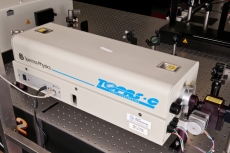Facilities
The Ultrafast Laser Laboratory has a purpose-built wet laboratory area as well as the following facilities:
Ti:Sapphire oscillator laser (Spectra Physics, Mai Tai SP)

This laser produces mode-locked pulses centred between 780 and 820 nm, with a pulsewidth of 30-100 fs and a rep-rate of 80 MHz. The laser features hands-free tuning and automated stability control. Part of the total 1 W power is used to seed the ultrafast amplifier, while the rest can be used as a standalone excitation source.

The amplifier is seeded by the Mai Tai oscillator (middle-right) and pumped by a 20 W Empower laser. The 4 W output of the amplifier has a rep-rate of 3 kHz, a centre wavelength of 800 nm and a pulsewidth of 100 fs.
A TOPAS C is pumped with output from the amplifier to provide automated wavelength tunability from 290-2600 nm. A home-built non-collinear OPA provides an additional tuneable excitation source that can be compressed to give <20 fs pulses.
Femtosecond transient absorption spectroscopy

We have custom-built TA data acquisition system. Excitation pulses are typically provided by the output of an OPA. The effect of excitation is probed by weak broadband visible-near infrared continuum pulses overlapping with the excited region of the sample.
The probe pulses are collected via fibre optics, spectrally resolved in a spectrograph, and recorded on photodiode arrays or CMOS cameras.We have used TA spectroscopy to resolve processes including photocurrent generation in photovoltaic cells, photoswitching behaviour, and light harvesting dynamics.
Ultrafast broadband photoluminescence spectroscopy
We have developed a new method to measure broadband PL spectra from the UV to near IR with ultrafast time resolution. Ultrafast PL spectra are gated via deflection from a transient grating formed via the interaction of a pair of gate pulses. The method enables us to resolve ultrafast light harvesting processes, exciton dynamics, and the onset of lasing.
Spectrally-resolved photocurrent
Steady-state photocurrent from solar cells is spectrally resolved via a system comprised of a Xe lamp coupled to a monochrometer for excitation, and a source-measurement unit for photocurrent measurement.
